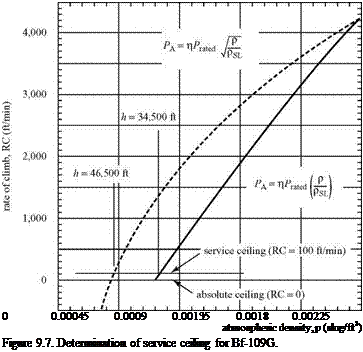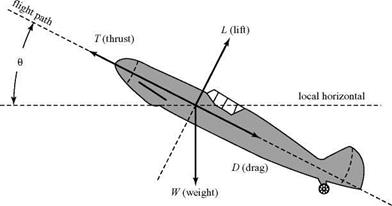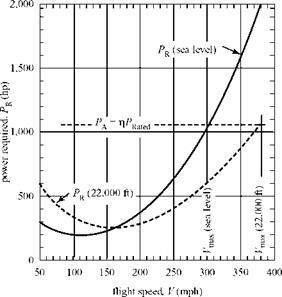Extension to High-Speed Flight
Although the material covered in this book is a necessary prerequisite for understanding basic aerodynamics, it is important to realize that the principles set forth may not be directly applicable to problems involving high-subsonic, supersonic, and hypersonic flight. Nevertheless, the analyses and concepts introduced are an important foundation on which to build high-speed aerodynamics. In particular, we find that more attention to the thermodynamic aspects of fluid mechanics is required. The density now becomes an important variable and considerably more use of the energy equation is demanded. That is, compressibility effects play a major role in the aerodynamics and performance of flight vehicles at high subsonic, supersonic, and hypersonic speeds.
[1] This may not be a correct picture of the motion in the case of free molecular flow at extremely high altitudes, where the mean free path can be very long.
[2] Standard SI and English-system symbols and units are used throughout this book. For example, N represents force in newtons, lbf is force in pounds, and kg is mass in kilograms; a slug is the basic unit of mass in the traditional English engineering system. Length in English units is in ft (feet) or in (inches); m is the metric unit of length in meters. Time in seconds is s or sec.
[3] Develop a theory for the flow and resulting pressure distributions on aerodynamic surfaces. Use integrated pressure forces to determine the force coefficients.
[4] Carry out a numerical simulation of the flow field over the wing.
[5] Build a model of the wing and measure the forces in a wind tunnel.
The projected wing area is S = 15.0 x 0.8 = 12.0 m2. Therefore, the full-scale drag at 135 km/hr is:
[7] In some cases, it may be necessary to include additional dynamic variables such as angular momentum in rotating fluids and, in other cases, additional thermodynamic properties such as the entropy, which is used to account for the reversibility of flow processes.
[8] Survey the control surface and note the magnitude and coordinate direction of any pressure (or shear) force acting on the control surface. If the force is not
[9] Using the vector identity:
V(u-v) = Vv+v-Vu + u x (Vxv) + v x (V xu) and setting u = v,
V(V-V) = 2V • VV + 2V x(Vx V).
Thus,
V• VV = v(v^ V)-V x(Vx V) = v(v2)-V x(Vx V).
[10] (фА) = A • Vф + фV• A
[11] analytical methods based on assumptions regarding the flow regime or the presence of small parameters in the problem
• experimental methods that seek to illuminate the problem by measurements and flow visualization in a laboratory environment or by instrumenting actual flight vehicles
• numerical methods that solve the appropriate sets of equations and boundary conditions by high-speed computation.
[12] Named after Daniel Bernoulli, a famous mathematician and physicist in the 1700s who made many important contributions to the study of hydrodynamics.
[13] Solve the Laplace’s Equation for the dependent variable ф(х, у) or у(х, у).
[14] Suitably differentiate this expression to determine the velocity components at any point.
[15] The constant coefficients that appear in these elementary solutions (often referred to as strengths) are assigned convenient arbitrary values when illustrating superposition in this chapter. However, in Chapter 5, in which it is required that superposition correspond to a specified body shape, the coefficients must be adjusted so that the composite solution matches the required boundary conditions.
[16] The radius of the cylinder and the resulting flow field may be changed by varying the freestream velocity and the strength of the doublet.
[17] The flow field is symmetrical with respect to both the x – and y-axes. This indicates that there is no net force on the cylinder in either the lift (i. e., vertical)
[18] On r = R, ur = 0. If ue = 0 as well, then:
Г
4nRV, ‘
[20] Named for M. Kutta, a German mathematician, and E. Joukouski, a Russian physicist, who
independently established the theorem during the early 1900s.
[21] Named after a British physicist who established the theorem in the late 1800s.
4.1 Find the equation of the streamline passing through the point (x = 2, y = 3) in a two-dimensional flow field where the velocity components are given by u = 3y2 and v = -2x.
4.2 A two-dimensional, steady flow field is described by:
(a) the equation of the streamlines, xy2/2 = constant
[22] Be careful not to confuse this term with wing loading, which is an important parameter in calculating the performance of a flight vehicle. Wing loading is defined as the weight of the flight vehicle divided by the wing-planform area.
[23] Geometric twist. Here, the wing has the same section shape from root to tip (e. g., NACA 0012 at every spanwise station), but the wing is physically deformed by twisting the tip relative to the root (Fig. 6.12a). This has the effect of changing the geometric angle of attack along the span so that a = a(y0). If the wing is twisted so that the geometric angle of attack of the tip is less than that of the root, this is termed wash-out. If the angle of attack at the tip is made greater than that at the tip, this is termed wash-in.
[24] Aerodynamic twist. Here, the geometric angle of attack for each wing section is the same across the span, but the wing sections change. For example, the section could be a symmetrical NACA 0012 at the root, a NACA 1410 at mid-semi-span, and a cambered NACA 2408 at the tip (Fig. 6.12b). Of course, the spanwise
[25] Named after Navier (France) and Stokes (England), who independently developed the equations in the early 1800s.















 Notice that at low speed, the power required is higher for the high-altitude case, whereas for high speeds, the opposite is true. This is due to of the parasite-drag penalty that dominates in the high-speed range. The effect of the induced drag becomes much smaller at high speeds, as indicated by Eq., 9.15. Therefore, the higher density for the low-altitude case results in more power required at a given flight speed.
Notice that at low speed, the power required is higher for the high-altitude case, whereas for high speeds, the opposite is true. This is due to of the parasite-drag penalty that dominates in the high-speed range. The effect of the induced drag becomes much smaller at high speeds, as indicated by Eq., 9.15. Therefore, the higher density for the low-altitude case results in more power required at a given flight speed.